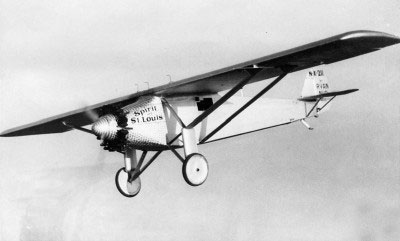Monday Milestone: The Spirit of St Louis
This Week in History
1927, May 20
Charles Lindbergh becomes the first man to successfully cross the Atlantic Ocean solo by air, winning the Orteig Prize
“Gentlemen: As a stimulus to the courageous aviators,I desire to offer, through the auspices and regulations of
the Aero Club of America, a prize of $25,000 to the first aviator of any Allied Country crossing the Atlantic in one flight,
from Paris to New York or New York to Paris, all other details in your care.”
– Raymond Orteig’s letter of offer for the competition
The crowd at Le Bourget Airport cheered.
An estimated 150,000 stormed the Paris airfield that day. Stories suggest they dragged Charles Lindbergh out of the cockpit and hoisted him aloft for almost half an hour, in what surely must be one of the earliest documented incidents of crowd surfing in history. Fair enough too. The man had just crossed the Atlantic Ocean alone.
The Delorean parks outside a French airfield amid a swelling crowd this week, all looking to the skies for a glimpse of the most recent American hero. As the Spirit of St Louis came into view, they erupted. Charles Lindbergh had just become the first man to fly solo across the Atlantic, securing himself not just a place in aviation immortality and American folklore, but also the coveted Orteig Prize.
In those days of pioneering flights, many lucrative prizes were established for long-haul, high-risk flights such as these. Plenty of incentive was required, because the consequences were severe.
Ever since Raymond Orteig, a French born, New York hotelier whose enthusiasm for French-American air travel had inspired a prize of $25,000 for the first pilot who successfully negotiated the Atlantic Ocean alone, many had tried unsuccessfully.
By 1927, six renowned aviators had already been killed, as the race for about a million dollars in today’s terms, intensified. WWI flying ace Rene Fonck over loaded his plane. Richard E. Byrd was forced to ditch in the Atlantic when fog surrounded Paris. Clarence D. Chamberlain achieved the feat, only his campaign was two weeks too late. He never expected Lindbergh to get there.
Nobody did. Charles Lindbergh was a relative newcomer to flying, despite his history as a former US Air Mail pilot. When he burdened his “partner”, his single-seat monoplane, the Spirit of St Louis, named for his then-hometown, with over a tonne of fuel on a muddy runway at Roosevelt Field in New York, he was considered something of a long shot.
Financed by a $15,000 bank loan, his own savings, and a few bucks he had made working for the Ryan Air Craft Company, Lindbergh’s entire life was invested in this flight. Imagine the panic as he barely cleared the telephone wires at the end of the runway. Even he must have worried if he’d ever make it.
Yet some 33.5 hours later, the Parisian crowd celebrated. He’d skimmed over storm clouds. He’d fought back icing, where freezing temperatures caused water ice to develop on the Spirit. He’d navigated by the stars, which of course proved even more difficult when he flew through several hours of thick fog.
But here he was, against all odds, landing in Paris and winning the Orteig Prize as the first man to fly solo across the Atlantic.
Today Charles Lindbergh and the Spirit of St Louis is part of American folklore. Unlikely heroes are often the best, and the significance of his achievement continues today.
Milestone Five: Significant flying achievements in the pioneering era of aircrafts
5. 1918 Manfred von Richthofen, also known as the Red Baron took flying to a new era with eighty combat victories during the great war, until he was ultimately shot down.
4. 1932 Amelia Earhart becomes the first woman to fly across the Atlantic solo
3. 1927 Charles Lindbergh wins the Orteig Prize when he becomes the first man to fly solo from New York to Paris
2. 1928 Sir Charles Kingsford Smith and partner Charles Ulm in the Southern Cross successfully negotiate the Pacific.
1. 1903 Orville and Wilbur Wright conduct the first heavier than air flight at Kitty Hawk, North Carolina

